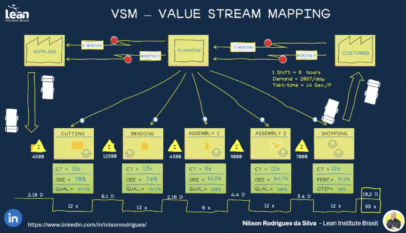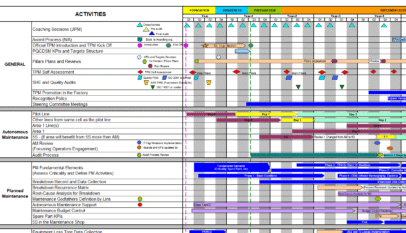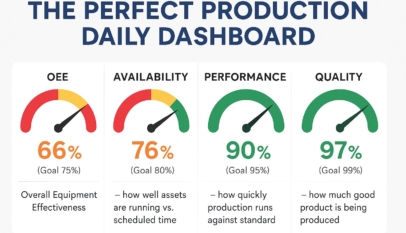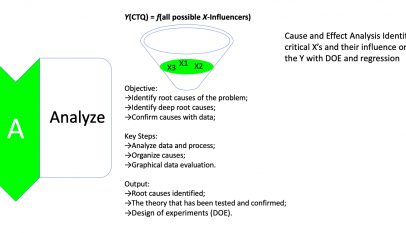Lean Manufacturing refers to a method of production that focuses on reducing waste and increasing efficiency by constantly improving processes and eliminating unnecessary steps.
Lean Manufacturing is a manufacturing philosophy that emphasizes minimizing waste and optimizing efficiency in the production process. It is based on the principles of the Toyota Production System, which Taiichi Ohno developed at Toyota Motor Corporation in the mid-20th century. The goal of lean Manufacturing is to create more value for the customer while using fewer resources. It is often achieved through just-in-time production, kanban systems, and continuous improvement.
The principles of lean Manufacturing have had a significant impact not only on the Manufacturing sector but also on other industries such as healthcare, software development and service industries. These principles have been widely adopted and adapted to improve efficiency and reduce waste in various fields.
What are the five principles of Lean Manufacturing?
The five principles of lean Manufacturing are:
- Identify value: Determine what customers want and need to create value for them.
- Map the value stream: Identify all the steps involved in creating the product or service, including both value-adding and non-value-adding steps.
- Create flow: Eliminate bottlenecks and obstacles that prevent the smooth and continuous flow of the product or service.
- Establish pull: Let the customer “pull” the product or service through the process rather than “push” it through.
- Pursue perfection: Continuously strive to improve the process and eliminate waste to create more value for the customer.
What are the seven types of waste in Lean Manufacturing?
The seven types of waste in lean Manufacturing are:
- Overproduction: Producing more than what is needed or the customer wants.
- Waiting: Delays in the production process due to lack of resources, poor communication, or other issues.
- Unnecessary motion: Excessive or unnecessary movement of people or equipment in production.
- Overprocessing: Performing unnecessary or excessive steps in the production process.
- Excess inventory: Holding more raw materials, work-in-progress, or finished goods than is needed.
- Defects: Rejects, rework, and scrap resulting from poor quality or faulty processes.
- Underutilized talent: Needs to utilize the skills and knowledge of employees fully.
It is believed that the Toyota Production System (TPS) laid out these seven types of waste and resources that could not add value for the customer.
Now that we know the different types of waste that should be minimized in Lean Manufacturing, it’s time to explore some common tools and techniques that can be used to reduce waste and improve production. These tools and techniques can help organizations implement lean manufacturing principles, increase efficiency, and ultimately create more value for the customer.
7 Lean Manufacturing Principles, Tools and Techniques That you Should Consider:
- Value Stream Mapping: Identify and map out the steps in the production process to better understand where waste is occurring and how to eliminate it.
- Kanban Systems: A visual system for managing the flow of materials and work-in-progress to create a pull-based production system.
- Just-In-Time (JIT) Production: A method of producing goods only as they are needed, reducing the amount of excess inventory.
- Total Productive Maintenance (TPM): A method of maintaining equipment and machinery to maximize production and minimize downtime.
- 5S: A set of five principles for organizing and maintaining a clean and orderly work environment (Sort, Simplify, Sweep, Standardize, Sustain).
- Root Cause Analysis (RCA): A method of identifying the underlying causes of problems to develop effective solutions.
- Continuous Improvement (CI): A method of continuously seeking and implementing improvements to the production process to increase efficiency and reduce waste.
Lean vs. Six Sigma
Lean and Six Sigma are both methodologies for improving efficiency and reducing waste in manufacturing and service industries, but they have some key differences.
Lean Manufacturing is based on the Toyota Production System (TPS) principles and emphasizes minimizing waste and optimizing efficiency in the production process. It focuses on creating more value for the customer while using fewer resources. It is often achieved through just-in-time production, kanban systems, and continuous improvement.
Six Sigma is a methodology that uses data and statistical analysis to identify and eliminate defects in the production process. It aims to achieve near-perfection by reducing variability and improving quality. It is often achieved using tools such as DMAIC (Define, Measure, Analyze, Improve, Control) and Six Sigma belts (White, Yellow, Green, Black, Master Black Belt).
Both Lean and Six Sigma are powerful tools for organizations to improve their processes, but they have different focuses; Lean is more on removing waste, while Six Sigma is more focused on reducing variability and improving quality.
What is Lean Six Sigma? How do Lean and Six Sigma integrate?
Lean Six Sigma is a methodology that combines the principles of Lean Manufacturing and Six Sigma to improve efficiency and reduce waste in the production process. It aims to achieve near-perfection by reducing variability and improving quality while minimizing waste and maximizing value for the customer.
Lean Six Sigma uses the DMAIC (Define, Measure, Analyze, Improve, Control) process, a structured problem-solving approach. It also utilizes the Six Sigma belts (White, Yellow, Green, Black, Master Black Belt) system for training and certifying practitioners.
The combination of Lean and Six Sigma allows for a more holistic approach to process improvement, as it considers eliminating waste and reducing variability and defects in the process. This results in a more efficient, effective and overall better production process.
Final Thought
In summary, Lean Manufacturing is a methodology that emphasizes minimizing waste and optimizing efficiency in the production process. It is based on the principles of the Toyota Production System and is often achieved through tools such as just-in-time production, kanban systems, and continuous improvement. Six Sigma is another methodology that uses data and statistical analysis to identify and eliminate defects in the production process and achieve near-perfection by reducing variability and improving quality.
Lean Six Sigma combines the principles of both Lean and Six Sigma to create a holistic approach to process improvement, which results in a more efficient, effective, and overall better production process. Lean and Six Sigma are powerful tools for organizations to improve their operations and create more value for the customer.


















The goal of TPM is the continuous improvement in effectiveness by small group activity of those who impact on it. That is a cross functional improvement process that engages users and leaders in day to day improvement. Not simply a method of maintaining. It is an equal partner in delivering no touch production and perfect flow. In its toolbox includes techniques to deliver flawless operation from day 1 for capital projects including advanced technology. Maybe look again at your definition.
That’s really great one! Complete philosophy of lean and six sigma
How do i register for the free training courses,i want to enroll,no link to register.
Best Regards.
Due to increased spam activity, regular registration on our site is temporarily suspended. You can register by purchasing a free template in our Shop section; once the checkout has been completed, you can select the course you want to enroll in. We’re sorry for the inconvenience.
https://learnfast.ca/shop/?orderby=price
There is not any section to get register/sign up.
Due to increased spam activity, regular registration on our site is temporarily suspended. You can register by purchasing a free template in our Shop section; once the checkout has been completed, you can select the course you want to enroll in. We’re sorry for the inconvenience.
https://learnfast.ca/shop/?orderby=price